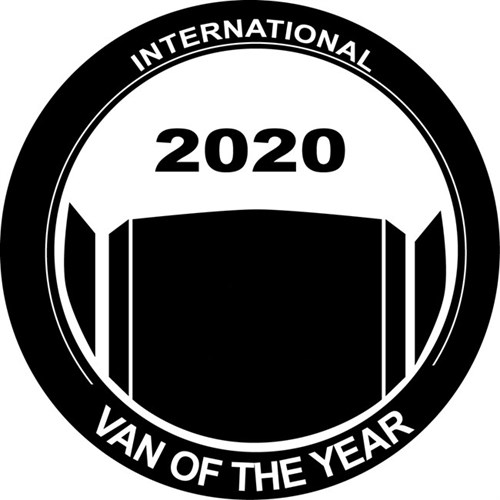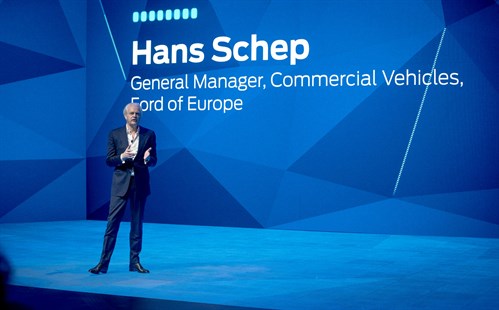“If we want to make a real difference, electrifying commercial vehicles is critical,” Roelant de Waard, Ford of Europe marketing vice president tells the gathered media at a recent Go Further event.
In previous years Ford has used the event to showcase its latest and greatest passenger car models, with the occasional and almost embarrassed inclusion of the odd LCV.
This year the message was different and commercial vehicles were front-and-centre in their ambitious 16-vehicle electrification strategy announcement. Steven Armstrong, Ford of Europe chairman, describes it as “change on an unprecedented scale” with eight new electrified vehicles set to be on the road by the end of the year, including hybrids of family favourites like the Fiesta, Focus and Mondeo.
But, vans have not been forgotten and following on from successful trials of 20 Transit Custom plug-in hybrids (PHEV) in London covering more than a combined 180,000km there will now be a plug-in version of the people mover, the Tourneo Custom.
The really big news, though, is an all-electric Ford Transit (main picture), a full battery electric vehicle (BEV) that will arrive not this year like the others above, but by 2021.
As you’d expect from a Transit van, it will be available in multiple body styles, lengths and heights, but will not, according to the manufacturer, suffer any losses in payload due to its electrification. Ford has already gathered a great deal of knowledge in the electric-LCV arena thanks to the Street Scooter Work XL conversions, which are carried out on Transit chassis in Cologne and used by parcel delivery giant DHL for urban deliveries.
The real-deal all-electric Transit might still be some way off, but other mild-hybrid (MHEV) options will arrive much sooner on Transit Courier, Transit Connect, Transit Custom and the big Transit itself. Also announced at Go Further was the company’s first mild-hybrid on a diesel powertrain – the EcoBlue Hybrid. Like the other MHEVs due to be launched that use a range of small petrol engines, the EcoBlue Hybrid will look to recover energy otherwise lost in braking to charge a battery which, to simplify things, is used to power ancillary devices and keep the alternator at its peak.
It’s a mid-point between conventional combustion and a full hybrid like the PHEVs but a step that is said to increase fuel economy in the Transit by 3% as a minimum but by as much as 8% for urban usage.
Armstrong describes it as “an attainable electric option for every Ford nameplate” while Ford general manager of commercial vehicles, Hans Schep, believes the new drivelines will succeed in opening up fleets to an even wider range of possibilities.
“The really interesting thing is there are so many changes coming, so many new opportunities to tailor them to use cases,” he says.
Using the example of DHL’s Street Scooter, the Transit based EV, Schep says Ford has learnt about the customer most likely to need to use electric vehicles.
“Street Scooter is very similar to how all home delivery works. We are using that Street Scooter knowledge for the last mile and definitely have learnt from that. We need to make sure we don’t lose that because if you build a battery electric vehicle for everyone it is not going to be a solution for many.”
While the electrification of the Ford product range is a huge step forwards for the company, Schep knows that customers are not going to switch overnight to the technology and the company does not expect to end the use of the combustion engine as a result. Instead the functionality of the new Transit BEV will be explained to customers and use-cases assessed to see if they really can fit into the current working life of their vehicles.
Schep says: “Commercial vehicles will have several propulsion options living alongside each other for a long time.
“Some will require diesel options, some will be able to switch to hybrid or battery-powered vehicles.
“There still are many fleets who must focus on their next vehicle and we will talk to them through Transit Centres and make sure they buy the right propulsion.”
With 950 Transit Centres across Europe and 111 in the UK alone, Ford will have its work cut out not only in explaining that message to its customers but also across the retail network.
The use cases for mild-hybrid, plug-in hybrid and battery vehicles will differ between countries, regions and even cities.
And while Schep says his customers want their electric vans to have a clear purpose – “The customer wants two things: generous range in all weathers, plus no compromise in getting the job done” – he appreciates that keeping ahead of the changes will be tough for them.
“Regulations are very changeable,” he observes.
“We want to take that anxiety away. We need to make sure our customers’ businesses move.”


Hans Schep believes the new drivelines will succeed in opening up fleets to an even wider range of possibilities.
(Continued from page 1) Of course, keeping businesses moving is one thing, but costs are often cited as the reason for fleets’ reluctance to adopt electric vehicles.
With so many electric vehicles either in the market or soon arriving in the market, paying a premium (and perhaps charging one) to be a green-fleet operator will become less likely.
The decision between combustion and battery-powered vehicles might then become more clear cut – you’ll either need to operate within a defined radius of base, most likely within a Clean Air Zone controlled city, and can therefore use an EV, or you’ll need to travel elsewhere for greater distances and can use a conventional diesel.
For those that fall between both camps a plug-in hybrid is a natural compromise, but the cost of having both a combustion engine as well as a battery pack and motor will mean PHEVs will not be suitable for everyone.
“Purchase price is not irrelevant for these vehicles.
“It is now all about cost of ownership. We will never be able to have a vehicle operating in a city centre if it is too expensive.
“Different operators look at different bits, and there are some customers who are interested in the latest technologies.
“They won’t pay any price, but they will pay a premium price [for PHEV],” says Schep.
Whatever propulsion system best suits your need, Ford is committed to having you connected to it in a way that enables you to get the most from the vehicle.
Ford Pass, currently available on passenger cars and small vans, will be rolled out with a new Ford Pass Pro offering.
The aim is 100% uptime for vehicles. Through the app, users will be able to check on the status of every individual vehicle, and drivers can see live as well as predicted health details.
The idea being that servicing and maintenance work can be combined to minimise time spent off the road.
A more fleet-focused Ford Telematics app will also be introduced later this year to give fleet managers even greater data with real-time information delivered through The Cloud.
Alternatively, the same information can be obtained through Ford Data Services and integrated with current telematics or management systems.
Schep describes it as “stepping up our collaboration to give better choice and more innovative services than before”. With an exciting range of vehicles to come to market and ever more connected solutions to link them, choice and innovation are at the forefront of the Ford Transit range.
Comment: Looking ahead
I find it really interesting to sit and listen to the experts from each of the manufacturers talk about their vision for electric vehicles.
There’s no denying they will, one day, replace petrol and diesel in the passenger car market, but for commercial vehicles I think there’s some way to go yet.
Not because the technology isn’t there or the use-case isn’t applicable, but because financially the numbers don’t quite stack-up. As all vehicles become more technologically advanced cost increases, you only have to look at the rising price of a smartphone to confirm that.
Will EVs go the same way? Manufacturers say not. They believe the price will only come down due to greater economies of scale with battery technology.
I, for one, am sceptical about that because there’s not yet a fixed formula for those batteries, and don’t even get me started on the charging infrastructure or the plug types being used. Collaboration is the way forward, like VW using ABT for the e-Caddy and e-Transporter. If more manufacturers looked to outside expertise I’d like to think EVs will become more affordable, better suited and more appropriate for commercial vehicles a lot faster.
George Barrow is the UK judge for the International Van of the Year, the prestigious prize awarded by leading European LCV journalists.






